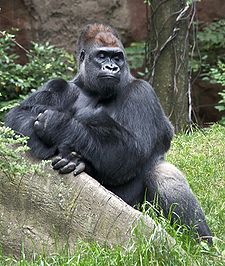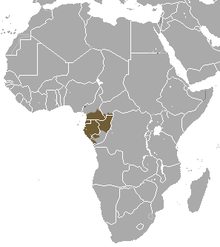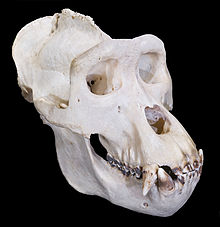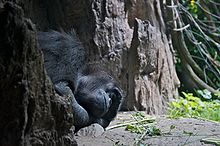- Western gorilla
-
Western gorilla[1] 
Conservation status Scientific classification Kingdom: Animalia Phylum: Chordata Class: Mammalia Order: Primates Family: Hominidae Genus: Gorilla Species: G. gorilla Binomial name Gorilla gorilla
(Savage, 1847)Subspecies 
Western gorilla range The western gorilla (Gorilla gorilla) is a great ape and the most populous species of the genus Gorilla.[3]
Contents
Taxonomy
Nearly all of the individuals of this taxon belong to the western lowland gorilla subspecies (G. g. gorilla) whose population is approximately 95,000 individuals [1]. There are fewer than 300 of the only other western gorilla subspecies, the Cross River gorilla (G. g. diehli).[4]
Appearance
The western gorilla is slightly smaller, lighter, more slender and clearer dyed than its eastern cousin. The western lowland gorilla can be brown or greyish with a yellowish forehead. It also has an overhanging tip on its nose, which the eastern gorilla does not have. Males measure 160–170 cm and weigh 140–160 kg. Females measure 120–140 cm and weigh 60–80 kg. The western gorilla is the smaller species of the gorilla. The Cross River gorilla differs from the western lowland gorilla in both skull and tooth dimensions. It is also about 10–15 cm taller and 20–35 kg heavier, but still smaller and lighter than the mountain gorilla and the eastern lowland gorilla, latter the largest subspecies of the gorilla and the largest living primate.
Behavior and ecology
Western gorillas live in groups that vary in size between 2 and 20 individuals, composed of at least one male, several females and their offspring. A dominant male silverback heads the group, with younger males usually leaving the group when they reach maturity. Females transfer to another group before breeding, which begins at eight to nine years old; they care for their young infant for the first three to four years of its life. There is therefore a long interval between births, which partly explains the slow population growth rates that make the western gorilla so vulnerable to poaching. Due to the long gestation time, long period of parental care, and infant mortality, a female gorilla will only give birth to an offspring that survives to maturity every six to eight years. Gorillas are long-lived and may survive for as long as 40 years in the wild.
Fruit forms a large part of the western gorilla's diet and they will travel further each day in search of fruiting trees than their eastern relatives. The distance that gorillas travel in the forest each day while they are searching for fruit trees varies between one and four kilometres. A group's home range may be as large as 30 square kilometres but is not actively defended. Wild western gorillas are known to use tools.[5]
A study published in 2007 in the American Journal of Primatology announced the discovery of the fighting back against possible threats from humans.[6] They "found several instances of gorillas throwing sticks and clumps of grass.[7]" This is unusual, because gorillas usually flee and rarely charge when encountered by humans.
Status
The World Conservation Union lists the western gorilla as critically endangered, the most severe denomination next to global extinction, on its 2007 Red List of Threatened Species. It is thought that the Ebola virus might be depleting western gorilla populations to a point where it might become impossible for them to recover, and the virus decimated populations in protected areas by one-third from 1992 to 2007.[2][3] Poaching, commercial logging and civil wars in the countries that compose the western gorillas' habitat are also threats.[3]
In the 1980s, a census taken of the gorilla populations in equatorial Africa was thought to be 100,000.[8] Researchers adjusted the figure after years of poaching and deforestation had reduced the population to approximately 50,000.[8] Surveys conducted by the Wildlife Conservation Society in 2006 and 2007 found more than 100,000 previously unreported gorillas have been living in the swamp forests of Lake Tele Community Reserve and in neighbouring Marantaceae (dryland) forests in the Republic of the Congo.[8] With the new discovery, the current population of western lowland gorillas could be around 150,000–200,000. However, the gorilla remains vulnerable to Ebola, deforestation, and poaching.[8]
Estimates on the number of Cross River gorillas remaining is about 280 in the wild, concentrated in approximately 11 locations. Recent genetic research[9] and field surveys suggest that these locations are linked by the occasional migration of individual gorillas. The nearest population of western lowland gorilla is some 250 km away. Both loss of habitat and intense hunting for bushmeat have contributed to the decline of this subspecies. A conservation plan for the Cross River gorilla was published in 2007 and outlines the most important actions necessary to preserve this subspecies.[10] Richard Black of the BBC has reported[11] that the government of Cameroon has created the Takamanda National Park on the border with Nigeria, as an attempt to protect these gorillas. The park now forms part of an important trans-boundary protected area with Nigeria’s Cross River National Park, safeguarding an estimated 115 gorillas—a third of the Cross River gorilla population—along with other rare species.[12] The hope is that the gorillas should be able to move between the Takamanda reserve in Cameroon over the border to Nigeria's Cross River National Park.
2008 Discovery
In mid 2008, researchers discovered as many as 125,000 previously-undiscovered gorillas in the Republic of Congo. This discovery could more than double the known population of the animals, though the effect that the discovery will have on the gorillas' conservation status is currently unknown.[13]
References
- ^ Groves, C. (2005). Wilson, D. E., & Reeder, D. M, eds. ed. Mammal Species of the World (3rd ed.). Baltimore: Johns Hopkins University Press. pp. 181-182. OCLC 62265494. ISBN 0-801-88221-4. http://www.bucknell.edu/msw3.
- ^ a b Walsh, P. D., Tutin, C. E. G., Oates, J. F., Baillie, J. E. M., Maisels, F., Stokes, E. J., Gatti, S., Bergl, R. A., Sunderland-Groves, J. & Dunn, A. (2008). Gorilla gorilla. In: IUCN 2008. IUCN Red List of Threatened Species. Downloaded on 4 January 2009.
- ^ a b c Planet Of No Apes? Experts Warn It's Close CBS News Online, 2007-09-12. Retrieved 2008-03-22.
- ^ "Animal Info - Gorilla". AnimalInfo.org. http://www.animalinfo.org/species/primate/gorigori.htm. Retrieved 2007-09-12.
- ^ "PLOS Journal "First Observation of Tool Use in Wild Gorillas"". Biology.plosjournals.org. 2005-10-01. doi:10.1371/journal.pbio.0030380. http://biology.plosjournals.org/perlserv/?request=get-document&doi=10.1371/journal.pbio.0030380. Retrieved 2009-07-03.
- ^ Wittiger, L. and Sunderland-Groves, J. 2007. Tool use during display behavior in wild cross river gorillas. American Journal of Primatology 69: 1307.
- ^ Science Daily
- ^ a b c d CNN (2008-08-05). "More than 100,000 rare gorillas found in Floral Park". CNN. http://www.cnn.com/2008/WORLD/africa/08/05/congo.gorillas/index.html. Retrieved 2008-08-05.
- ^ Bergl, R. A. and Vigilant, L. 2007. Genetic analysis reveals population structure and recent migration within the highly fragmented range of the Cross River gorilla (Gorilla gorilla diehli). Molecular Ecology 16: 501–516.
- ^ Regional Action Plan for the Conservation of the Cross River Gorilla
- ^ BBC News website Protection boost for rare gorilla 28th November 2008 http://news.bbc.co.uk/1/hi/sci/tech/7754544.stm
- ^ New National Park Protects World's Rarest Gorilla Newswise, Retrieved on November 28, 2008.
- ^ Font size Print E-mail Share 33 Comments (2008-08-05). "Thousands Of Rare Gorillas Found In Congo". Cbsnews.com. http://www.cbsnews.com/stories/2008/08/05/tech/main4321037.shtml. Retrieved 2009-07-03.
Extant species of family Hominidae (Great apes) Kingdom: Animalia · Phylum: Chordata · Class: Mammalia · Order: Primates · Suborder: Haplorrhini Ponginae Homininae Category Ape-related articles Ape species 
Ape study Ape language · Ape Trust · Dian Fossey · Birutė Galdikas · Jane Goodall · Chimpanzee genome project · Human genome project · Neanderthal genome project · Willie Smits · Lone Drøscher Nielsen · Borneo Orangutan SurvivalLegal and social status See also Bushmeat · Ape extinction · List of notable apes · List of fictional apes · Human evolution · Mythic humanoids · HominidCategories:- IUCN Red List critically endangered species
- Mammals of Africa
- Mammals of Angola
- Mammals of Cameroon
- Mammals of the Central African Republic
- Mammals of the Republic of the Congo
- Mammals of Equatorial Guinea
- Mammals of Gabon
- Mammals of Nigeria
- Tool-using species
- Gorillas
- Animals described in 1847
Wikimedia Foundation. 2010.



